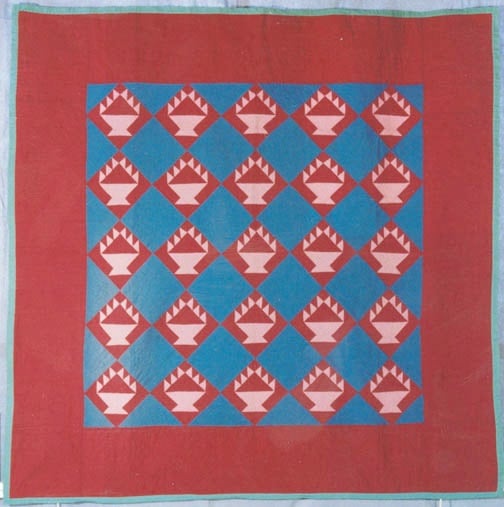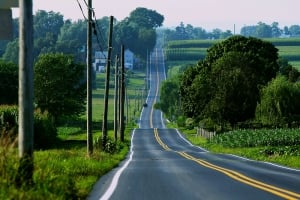Ben Riehl On His Father David
In a post last week, I mentioned visiting Manhattan with my friend Ben Riehl in search of the dealers where his father David once sold antique Amish quilts. I also shared a bit from his related 2018 talk at Elizabethtown College.
Ben has kindly passed along a written version of that talk which I’ve posted below. If you missed the original post, David Riehl was a key figure in the promulgation of the Amish quilts industry. He took Amish quilts from Lancaster County into New York City to sell them directly to dealers.
Here’s Ben’s talk in full, in which he fills out some more details of his Dad’s story.
My Dad’s name was David Riehl. But to the Madison Avenue art dealers in NYC he was known as the Amish Connection. What he did was buy antique Amish quilts from his co-religionists and then sold them to these Madison Avenue art dealers who then resold them as works of art.
Other than the fact that he needed the money, how he got started was probably the fact that he liked public auctions and he noticed these quilts being sold to pickers and dealers. He began asking questions and he figured out these quilts wind up in New York City. So he decides to buy a few both at auction and privately, and he assumed that his best bet would be to go to Christie’s Auction House in New York City. He fills a suitcase and gets on the train and heads for Christie’s.
Once there the receptionist who also happened to be from Lancaster County suggested he go to the Upper East Side and try selling these quilts to the art shops located there.
Now this happened in the 1980s, a time before the TV show Amish in the City, back when Amish in NYC were like Eskimos in Kansas, as Ed Klimuska put it.
So the fact that the Christie’s receptionist was also from Lancaster County made Dad a familiar figure to her, which was a plus for Dad to orient himself in starting this new venture.
Ed Klimuska of the Lancaster New Era newspaper said that Dad discovered that showing mint condition antique Amish quilts to these highbrow art dealers was like showing sirloin to watchdogs.
They all wanted him to visit their shops first. Now the art dealer crowd in NYC is numerically rather small and very interconnected. They all knew each other. So they talked about Dad and jockeyed with each other to build the best relationship with Dad.

Baskets, unidentified Amish maker in the style of Mary Stoltzfus Lapp, c. 1920, Lancaster Co., Pennsylvania. International Quilt Study Center & Museum, University of Nebraska-Lincoln
There are a few stories of how they tried to get him to come to them first.
One is when Judi Boisson, a dealer, spotted him on Madison Avenue. So she stops her van in the middle of the street, lets everybody scream at her, and gets Dad to go with her.
Another one is when Dad was in a taxi slowing down around a corner. When the door opened a guy pays his fare and wants to talk. Dad first thinks that he is getting mugged, but it turns out that this was another quilt dealer who wanted to talk.
In the end the shops he visited first were the ones he knew would pay him what he wanted for his quilts with the least hassle.
So Dad did definitely have what the highbrow dealers would call chutzpah. And it served him well not only with the art dealers but with the people he had to buy the quilts from.
Those people, the Amish, were in many ways the polar opposite of the people he was selling to. They would have said that Dad is vennich grusdich which means about the same thing as chutzpah.
The Amish have a reputation for being frugal, hard-working and very practical. Since he was familiar with the culture, Dad knew how to apply the psychology in order to make them sell. He would use tactics like laying out the cold hard cash when he made his offer. He knew that economics trumped the artistic value, and once the price was high enough, it also trumped the sentimental value of these quilts that had no practical use and were being stored in blanket chests because of sentimental value.
He also knew and implicitly reminded them that sharing $3,000 with your eight children is much easier than sharing one quilt with those same eight children. Dad very soon had his reputation established that he is the guy to sell to.
 Tumbling Blocks, unknown Amish maker, c. 1935, Holmes County, OH. Courtesy of Faith and Stephen Brown
Tumbling Blocks, unknown Amish maker, c. 1935, Holmes County, OH. Courtesy of Faith and Stephen Brown
So all in all Dad in about 8-10 years bought and sold 100+ quilts. And he had a lot of fun doing it.
It matched his personality perfectly and he made a decent sum of money which he certainly needed, as some of his more mundane retail greenhouse and outdoor furniture ventures were met with a lot less financial success. And it sure beat working at the RV factory. And Dad was very certainly not a farmer, even though most farmed at that time.
In the later years once the quilts were all gone, he still bought other antiques, primarily Barbara Ebersol paintings, fraktur art, and Henry Lapp furniture. But that was much easier, as he had a one-on-one relationship with antique dealer David Wheatcroft, who paid Dad a good commission for his buys. That relationship was based completely on trust and goodwill.
That way he still made a little money and kept his feet in the art world somewhat. And by then he had much more of an appreciation of the artistic value of the objects he was buying and selling, than he had at first.
So he learned a lot as well and broadened his horizons and had quite a few interesting experiences in his role in the quilt story.
Thanks to Ben for sharing. Long-time readers might remember Ben from his previous talk on the Amish at Kutztown University or this Amish business video. He also answered the questions in this interview from way back.
He and his family run Country Style Deli at the Markets at Shrewsbury in York County, PA. If you’re in the area, I encourage you to drop in and say hello and ask him about his dad (and while you’re at it, try my favorite, the Riehl McCoy sub).








Hours
If the hours of creative labor going into some of these quilts is considered, several thousand dollars each seems almost inadequate. So much designing, cutting, stitching, mostly, or all, by hand. Art may be hard to define but you know it when you see it.
Not to mention we had an example a week or two back of a quilt in a plainer community in NY selling for around $400. That seems especially low, but things are usually cheaper in the smaller and plainer places.
a better reason to visit Lancaster County!
What a great story! Would love to chat about the Riehl McCoy – “vielen Dank” for the post.
I’m glad you liked it Jeanne-Catherine. Definitely go say hi if you have a chance, and I don’t know if you’ve been to an Amish market before, but it’s a nice experience in and of itself.